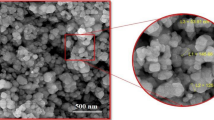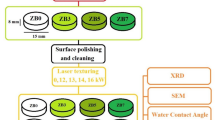Abstract
Ceramic dental materials, especially alumina (20 %vol)-yttrium stabilized tetragonal zirconia poly crystal (A-Y-TZP20), have been considered as alternatives to metals for endosseous dental implant application. For increasing the bone-to-implant contact as well as the speed of bone formation, a new surface modification can be effective. The aim of this study was to design microgroove patterns by femtosecond laser on A-Y-TZP20 nano-composite disks for endosseous dental implant application. The phase composition and the morphology of the A-Y-TZP20 nano-composite samples were characterized using X-ray diffraction and Scanning electron microscopy equipped with energy dispersive X-ray spectroscopy techniques. Statistical analysis was submitted to Kolmogorov-Smirnov test and Student’s t test for independent variables, with a 5 % significance level. EDAX analysis revealed a significant decrease in the relative content of contaminants like carbon (p < 0.05) in laser surface-treated group as compared to non surface-treated group. X-ray diffraction did not show any change in the crystalline structure induced by laser processing. It was concluded that the femtosecond laser is a clean and safe method for surface modification of A-Y-TZP20.








Similar content being viewed by others
References
Mesa F, Muñoz R, Noguerol B, De dios Luna J, Galindo P, O’Valle F (2008) Multivariate study of factors influencing primary dental implant stability. Clin Oral Implants Res 19:196–200
Ersanli S, Karabuda C, Beck F, Leblebicioglu B (2005) Resonance frequency analysis of one-stage dental implant stability during the osseointegration period. J Periodontol 76:1066–1071
Fanuscu MI, Chang TL, Akça K (2007) Effect of surgical techniques on primary implant stability and peri-implant bone. J Oral Maxillofac Surg 65:2487–2491
Shalabi MM, Gortemaker A, Van’t Hof MA, Jansen JA, Creugers NH (2006) Implant surface roughness and bone healing: a systematic review. J Dent Res 85:496–500
Gupta A, Dhanraj M, Sivagami G (2010) Status of surface treatment in endosseous implant: a literary overview. Indian J Dent Res 21:433–438
Chen J, Bly RA, Saad MM, AlKhodary MA, El-Backly RM, Cohen DJ, Kattamis N, Fatta MM, Moore WA, Arnold CB, Marei MK, Soboyejo WO (2007) In-vivo study of adhesion and bone growth around implanted laser groove/RGD-functionalized Ti-6Al-4V pins in rabbit femurs. Material Science and Engineering C, 31: 826–832
Huang YH, Xiropaidis AV, Albabdar RG, Hall J, Wikesjo UME (2005) Bone formation at titanium porous oxide (TiUniteTM) oral implants in type bone. Clin Oral Impl Res 16:105–111
Grassi S, Piattelli A, Figueiredo LC, Feres M, Melo L, Iezzi G, Alba RC, Shibli JA (2006) Histologic evaluation of early human bone response to different implant surfaces. J Periodontol 77:1736–1743
Stadlinger B, Hennig M, Eckelt U, Kuhlisch E, Mai R (2010) Comparison of zirconia and titanium implants after a short healing period. A pilot study in minipigs. Int J Oral Maxillofac Surg 39:585–592
Kelly JR, Denry I (2008) Stabilized zirconia as a structural ceramic: an overview. Dent Mater J 24:289–298
Langhoff JD, Voelter K, Scharnweber D, Schnabelrauch M, Schlottig F, Hefti T (2008) Comparison of chemically and pharmaceutically modified titanium and zirconia implant surfaces in dentistry: a study in sheep. Int J Oral Maxillofac Surg 37:1125–32
Gahlert M, Röhling S, Wieland M, Sprecher CM, Kniha H, Milz S (2009) Osseointegration of zirconia and titanium dental implants: a histological and histomorphometrical study in the maxilla of pigs. Clin Oral Implants Res 20:1247–53
Lee J, Sieweke JH, Rodriguez NA, Schüpbach P, Lindström H, Susin C (2009) Evaluation of nano-technology-modified zirconia oral implants: a study in rabbits. J Clin Periodontol 36:601–7
Ferguson SJ, Langhoff JD, Voelter K, Rechenberg B, Scharnweber D, Bierbaum S (2008) Biomechanical comparison of different surface modifications for dental implants. Int J Oral Maxillofac Implants 23:1037–46
Pirker W, Kocher AA (2009) Immediate, non-submerged, root-analogue zirconia implants placed into single-rooted extraction sockets: 2-year follow-up of a clinical study. Int J Oral Maxillofac Surg 38:1127–32
Delgado-Ruíz RA, Calvo-Guirado JL, Moreno P, Guardia J, Gomez-Moreno G, Mate-Sánchez JE (2007) Femtosecond laser microstructuring of zirconia dental implants. J Biomed Mater Res B Appl Biomater 96:91–100
Lu J, Rao MP, MacDonald NC, Khang D, Webster TJ (2008) Improved endothelial cell adhesion and proliferation on patterned titanium surfaces with rationally designed, micrometer to nanometer features. Acta Biomaterial J 4:192–201
Lamers E, Horssen R, Riet J, Delft CF, Walboomers RL (2010) The influence of nanoscale topographical cues on initial osteoblast morphology and migration. Eur Cell Mater 20:329–43
Loesberg WA, Riet J, Delft FC, Schön P, Figdor CG, Speller S (2007) The threshold at which substrate nanogroove dimensions may influence fibroblast alignment and adhesion. Biomaterials 28:3944–51
Lamers E, Walboomers FX, Domanski M, Riet J, Delft FC, Luttge R (2010) The influence of nanoscale grooved substrates on osteoblast behavior and extracellular matrix deposition. Biomaterials 31:307–16
Klein MO, Bijelic A, Toyoshima T, Götz H, Koppenfels RL, Al-Nawas B (2010) Long-term response of osteogenic cells on micron and submicron-scale-structured hydrophilic titanium surfaces: sequence of cell proliferation and cell differentiation. Clin Oral Implants Res 21:642–9
Minamizato T (1990) Slip-cast zirconia dental roots tunnels drilled by laser process. J Prosthet Dent 63:677–684
Hao L, Lawrence J, Chian KS (2004) Effects of CO2 irradiation on the surface properties of magnesia-partially stabilised zirconia (MgOPSZ) bioceramic and the subsequent improvements in human osteoblast cell adhesion. J Biomater Appl 19:81–105
Hao L, Lawrence J, Chian KS (2005) Osteoblast cell adhesion on a laser modified zirconia based bioceramic. J Mater Sci Mater Med 16:719–726
Hao L, Lawrence J (2006) Effects of Nd:YAG laser treatment on the wettability characteristics of a zirconia-based bioceramic. Opt Lasers Eng 44:803–814
Barsch N, Barcicowski S, Baier K (2008) Ultrafast laser processed zirconia and its adhesion to dental cement. J Laser Micro Nano Eng 3F:78–83
Stubinger S, Homann F, Etter C, Miskiewicz M, Wieland M, Sader R (2008) Effect of Er:YAG, CO2 and diode laser irradiation on surface properties of zirconia endosseous dental implants. Lasers Surg Med 40:223–228
Tang D, Lim HB, Lee KJ, Lee CH, Cho WS (2011) Evaluation of mechanical reliability of zirconia-toughned alumina composites for dental implants. Ceramic Int 38:2429–2436
Rocchietta I, Fontana F, Addis A, Schupbach P, Simon M (2009) Surface-modified zirconia implants: tissue response in rabbits. Clin Oral Impl Res 20:844–850
Pirker W, Kocher A (2008) Immediate, non-submerged, root-analogue zirconia implant in single tooth replacement. Int J Oral Maxillofac Surg 37:293–295
Kohal RJ, Wolkewitz M, Hinze M, Han J, Bächle M, Butz F (2009) Biomechanical and histological behavior of zirconia implants: an experiment in the rat. Clin Oral Implants Res 20:333–339
Ko HC, Han JS, Bachle M, Jang JH, Shin SW, Kim DJ (2007) Initial osteoblast-like cell response to pure titanium and zirconia/alumina ceramics. J Dental Mat 23:1349–1355
Chichkov BN, Momma C, Nolte S, Von Alvensleben A, Tünnermann A (1996) Femtosecond, picosecond and nanosecond laser ablation of solids. Appl Phys 63:109–115
Shrink MD, Molian PA (1998) A review of ultrashort pulsed laser ablation of materials. J Laser Appl 10:18–28
Roy S, Modest MCW (1993) Laser machining of hard ceramics—I. Effects of three-dimensional conduction, variable properties and various laser parameters. Int J Heat Mass Transf 36:3515–3528
Atanasov PA, Eugenieva ED, Nedialkov NN (2001) Laser drilling of silicon nitride and alumina ceramics: a numerical and experimental study. J Appl Phys 89:2013–2016
Garvie RC, Nicholson PS (2006) Phase analysis in zirconia systems. J Am Ceram Soc 55:303–305
Engquist BA, Strand P, Dahlgren S, Engquist E, Feldmann H, Gro Ndahl K (2002) Marginal bone reaction to oral implants: a prospective comparative study of Astra Tech and Branemark System implants. Clin Oral Implants Res 13:30–37
Delgado-Ruiz RA, Markovi A, Calvo-Guirado JL, Lazi Z, Piattelli A, Boticelli D, Mate-Sancheez JE, Negri B, Ramirez-Fernandez MP, Misi T (2014) Implant stability and marginal bone level of microgrooved zirconia dental implants: a 3-month experimental study on dogs. J Vojnosanil Pregl 71:451–461
Massaro C, Rotolo P, De Ricardis F, Milella E, Napoli A, Wieland M, Textor M, Spencer ND, Brunette DM (2002) Comparative investigation of the surface properties of commercial titanium dental implants, part 1: chemical composition. J Mater Sci Mater Med 13:535–548
Acknowledgments
The authors would like to specially thank Professor Jukka and Dr. Liu Dan at Dental Material Department in University of Hong Kong and Professor Savabi at School of Dentistry, at Isfahan University of Medical Sciences, for their scientific supports and cooperation.
Author information
Authors and Affiliations
Corresponding author
Rights and permissions
About this article
Cite this article
Aivazi, M., hossein Fathi, M., Nejatidanesh, F. et al. The evaluation of prepared microgroove pattern by femtosecond laser on alumina-zirconia nano-composite for endosseous dental implant application. Lasers Med Sci 31, 1837–1843 (2016). https://doi.org/10.1007/s10103-016-2059-8
Received:
Accepted:
Published:
Issue Date:
DOI: https://doi.org/10.1007/s10103-016-2059-8




